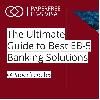EB-5 Due Diligence: Selecting the Right Project for Your Investment |Paperfree Guide
Master EB-5 due diligence with our Paperfree Guide. Get essential tips for selecting the right project. Explore the intricacies of EB-5 projects for confident investment decisions.last updated Friday, April 11, 2025
#eb 5 due diligence checklist #eb 5 due diligence
| | by Sidra Jabeen | Content Manager, Paperfree Magazine |

QUICK LINKS
AD
Get Access to EB 5 Investment Visa Resources
Key Points:
- EB-5 investors must conduct thorough due diligence on the project and the regional center.
- Key steps include reviewing legal, financial, and immigration documents, project feasibility, and job creation potential.
- On-site visits and background checks on developers and management teams are crucial.
- Investors should verify USCIS designation and the project's job creation capacity and ensure funds are "at risk."
- Monitoring and consultation with legal and financial advisors are essential for minimizing risks and ensuring a successful EB-5 investment.
- Transparency and clear communication with regional centers enhance trust and security.
Understanding EB-5 Due Diligence
EB-5 investors must conduct thorough due diligence to ensure the success of their investment and immigration goals. The EB-5 program offers a pathway to U.S. residency through investments in approved projects, but this comes with significant financial and legal risks. Proper due diligence minimizes these risks and increases the likelihood of a successful visa petition.
The EB-5 due diligence process involves reviewing critical documents, assessing the track record of the regional center, and verifying compliance with USCIS regulations. Investors use a detailed EB-5 due diligence checklist to guide their research. This process helps investors safeguard their capital and ensures the project has the potential to create the required jobs for EB-5 visa approval.
By focusing on thorough due diligence, investors can protect their financial interests and increase the likelihood of a successful outcome in both their immigration process and their investment return.
What is EB-5 Due Diligence?
EB-5 due diligence is the process of thoroughly investigating an EB-5 project before committing investment funds. This crucial step ensures that the project meets the requirements for U.S. immigration and financial standards. It is essential for investors to validate claims made by the project developers, assess potential risks, and ensure that the project aligns with the investor’s financial goals and immigration objectives.
How to Perform EB-5 Due Diligence:
- Review Key Documents
The first step in EB-5 due diligence is to obtain and review all relevant documents. These typically include the business plan, financial projections, market feasibility studies, and investment contracts. Investors should ensure that the documents are clear, comprehensive, and meet the requirements set by USCIS. - Assess Legal and Financial Risks
Evaluate the investment's legal structure and financial projections. This includes understanding the Private Placement Memorandum (PPM), assessing the developer’s track record, and verifying the project’s compliance with EB-5 regulations. - Verify USCIS Compliance
The project must be approved by USCIS to ensure that the investment will lead to immigration benefits. Confirm the regional center’s USCIS designation and the project’s eligibility under the EB-5 program. - Analyze Economic Impact
Assess the economic impact report, particularly the job creation projections. The project must demonstrate that it will create the required 10 full-time jobs per investor. - Engage Legal and Financial Advisors
Consult with experts specializing in EB-5 investments to confirm that the due diligence process is comprehensive and that all potential risks are addressed.
The EB-5 Due Diligence Process
The EB-5 due diligence process involves essential steps that help investors assess the viability and risks associated with an EB-5 investment. This thorough review provides transparency, enabling investors to make informed decisions about their financial and immigration future.
How to Navigate the EB-5 Due Diligence Process:
- Document Review
Begin by carefully reviewing all relevant project documents. This includes the business plan, financial statements, market feasibility studies, and contracts. The aim is to verify the accuracy of the information provided and assess the financial health of the project. - Financial Analysis
Scrutinize the financial projections and past performance of the project. This includes assessing revenue streams, potential risks, and the financial stability of the developer. Ensure that the project has a solid financial plan and can generate returns for investors. - Investment Structure Evaluation
Understand the investment structure and the terms outlined in the Private Placement Memorandum (PPM) and other investment agreements. Pay attention to the exit strategies, distribution schedules, and potential liabilities. This will help you understand your rights and responsibilities as an investor. - Regional Center Due Diligence
Verify the regional center’s USCIS designation and its track record in handling EB-5 projects. Research the center’s success rate with past projects, including the number of investors who received their green cards. - Immigration Viability
Ensure that the project has the potential to fulfill EB-5 immigration requirements. This includes confirming that the project will create at least 10 full-time jobs per investor and is located in a Targeted Employment Area (TEA), if applicable. - Engage Advisors
Work with immigration attorneys and financial advisors who specialize in EB-5 investments. Their expertise can help you interpret documents, identify potential risks, and ensure the project complies with all legal and regulatory requirements.
EB-5 Regional Center Due Diligence
EB-5 regional center due diligence is crucial for investors to verify that the regional center is reliable, financially stable, and capable of managing the EB-5 project. A regional center is the intermediary between investors and the project developers, so understanding its track record and operational efficiency is key to a successful EB-5 investment.
How to Perform EB-5 Regional Center Due Diligence:
- Verify USCIS Designation
Confirm that the regional center has an active designation from USCIS. This ensures that the regional center is authorized to sponsor EB-5 projects. You can check the USCIS website for the current status of the regional center and its past designations. - Evaluate Past Successes
Investigate the regional center’s history of successful projects. Look for the number of EB-5 investors who have successfully obtained green cards through the center. Assess whether the regional center has a proven track record of meeting job creation requirements and immigration outcomes. - Examine Financial Stability
Review the regional center’s financial status by looking at its annual I-924A filings, which detail its financial health and compliance with EB-5 regulations. Independent audits of the regional center’s finances can provide transparency regarding its operations and financial stability. - Leadership and Management Evaluation
Assess the experience and qualifications of the regional center’s leadership team. Investigate their background in real estate, finance, and immigration law. A strong leadership team with relevant experience increases the likelihood of the project’s success. - Assess Communication and Investor Relations
Evaluate how well the regional center communicates with investors. Ensure that it provides regular updates, reports, and financial disclosures. A responsive and transparent regional center builds trust with investors and provides assurance about the investment’s progress.
Mitigating Risks in EB-5 Projects
Mitigating risks in EB-5 projects is essential to ensure the safety of your investment and achieve the desired immigration outcome. Due diligence plays a significant role in identifying and addressing potential risks before committing to an EB-5 project. By understanding the key risks involved and taking proactive steps, investors can protect their funds and increase the likelihood of a successful EB-5 investment.
How to Mitigate Risks in EB-5 Projects:
- Thorough Document Review
Carefully examine the project's financial documents, business plans, and market feasibility studies. Look for red flags such as unrealistic revenue projections or discrepancies in the business plan. A well-researched and detailed business plan reduces the risk of project failure. - Assess Developer Experience
Evaluate the experience and track record of the project developer. A developer with a history of successful EB-5 projects is less likely to encounter issues that could jeopardize the investment. Look for previous projects with a successful completion and a strong job creation record. - Verify Job Creation Projections
Ensure that the project can meet the job creation requirements of the EB-5 program. Verify the economic impact analysis and job creation projections with third-party experts. A project that aims to create more than 10 jobs per investor provides a buffer against potential delays or challenges in meeting job creation goals. - Diversify Investment
Spread your investment across multiple projects or regional centers to reduce risk exposure. Avoid concentrating your investment on a single project or region, as this could leave you vulnerable if the project encounters financial or operational challenges. - Understand the Escrow Agreement
Ensure your investment funds are held in a secure escrow account and not released until the project meets specific milestones. The escrow agreement should clearly outline the terms for fund release, protecting your capital in case of project delays or failure. - Engage Legal and Financial Experts
Work with professionals who specialize in EB-5 investments. A legal or financial advisor can help you identify potential risks, review project documents, and ensure compliance with EB-5 regulations. Their expertise can guide you through the process and provide reassurance that the project is legitimate and viable. - Monitor Project Progress
Stay informed about the progress of the EB-5 project by regularly reviewing updates from the regional center and developers. Ensuring that milestones are met on time and that job creation targets are being achieved will help mitigate risks throughout the investment period.
EB-5 Due Diligence Timeline
The EB-5 due diligence process is a critical step in evaluating potential investments. It involves reviewing a range of documents, verifying financial stability, and ensuring the project’s compliance with USCIS requirements. Understanding the typical timeline for this process will help investors stay organized and avoid unnecessary delays.

How to Navigate the EB-5 Due Diligence Timeline:
- Initial Research (1-2 Weeks)
Start by conducting preliminary research on the EB-5 project. This involves reviewing the project's website, available marketing materials, and the regional center’s track record. Verify the basic eligibility of the project and its USCIS designation. At this stage, you should also gather project documents, such as the business plan and financial projections. - Document Review and Financial Assessment (2-3 Weeks)
After gathering key documents, thoroughly review them. Focus on the business plan, market feasibility studies, and investment agreements. Evaluate the financial health of the project, including financial statements, cash flow projections, and job creation plans. Engage legal and financial experts to help assess the validity and potential risks involved. - Regional Center Due Diligence (2-4 Weeks)
During this stage, perform detailed due diligence on the regional center. Verify its USCIS designation, review past project successes, and analyze the center’s financial stability. Assess the leadership team’s qualifications and their experience in managing similar projects. The timeline for this step can vary depending on the availability of information and the complexity of the regional center’s operations. - On-Site Visit and Project Evaluation (2-3 Weeks)
If possible, plan an on-site visit to the project location. This visit allows you to evaluate the progress of the project, inspect the facilities, and meet with key personnel. It’s essential to verify construction timelines, assess any environmental risks, and ensure that the project is progressing as planned. If an on-site visit is not feasible, request video tours or additional documentation from the project developers. - Final Assessment and Decision-Making (1-2 Weeks)
Once you have completed all the necessary research, financial assessments, and due diligence checks, make your final evaluation. Consult with your legal and financial advisors to determine whether the project aligns with your investment and immigration goals. Ensure that you are comfortable with the risks involved and that the project meets all EB-5 requirements. - Investing and Preparing for I-526 Filing
After completing due diligence and finalizing your decision, proceed with the investment. The next step is filing the I-526 petition, demonstrating that your investment meets EB-5 requirements. Ensure that the petition is complete and accurate before submission.
Legal and Financial Documentation for EB-5 Investors
Legal and financial documentation is essential for ensuring an EB-5 investment is legitimate, secure, and compliant with U.S. immigration laws. These documents provide transparency about the investment structure, the project’s financial health, and the legal responsibilities of the investor.
How to Review Legal and Financial Documentation for EB-5 Investments:
- Private Placement Memorandum (PPM)
The PPM is a crucial document that outlines the terms of the investment, including the project’s financial projections, risk factors, and exit strategies. As an investor, carefully review the PPM to understand the scope of the investment, potential risks, and the expected return on investment (ROI). Ensure the PPM complies with U.S. securities laws and clearly explains the project’s legal and financial terms. - Operating Agreement or Limited Partnership Agreement
This document outlines the rights and responsibilities of the investor, including voting rights, profit distribution, and potential liabilities. It is essential to ensure that the terms of the agreement are fair and protect your interests as an investor. Verify that the operating agreement aligns with the PPM and includes investor exit and dispute resolution provisions. - Escrow Agreement
The escrow agreement details how investor funds will be handled. It is important to verify that the escrow agent is independent of the developer and has a solid reputation. Please review the terms under which funds will be released, ensuring they are tied to project milestones such as job creation and construction progress. The escrow agreement helps safeguard your investment by ensuring that funds are only used for the project as intended. - Subscription Agreement
This document formalizes your commitment to the investment and specifies the amount of capital you invest. It also outlines the payment terms and refund policies. Ensure the subscription agreement reflects your investment commitment and protects your interests. It is also essential to confirm that the agreement aligns with the terms outlined in the PPM and operating agreement. - Project Financials
Review the project’s historical and projected financial statements. These documents should provide an overview of the project’s revenue, expenses, profitability, and financial health. Pay close attention to any debt financing the project may rely on and assess how it may impact the return on your investment. Independent audits of the project’s financials can provide an added layer of assurance regarding the project’s stability. - Immigration Forms and Compliance
Ensure that all immigration-related documents, such as the I-526 petition and other USCIS forms, are accurate and complete. Verify that the project meets all EB-5 program requirements, including job creation and the investment amount. Consulting with an immigration attorney can help ensure all forms are correctly filed and comply with USCIS regulations.
Evaluating Project Feasibility and Job Creation
For an EB-5 investment to be successful, it must meet the job creation requirement and demonstrate financial feasibility. The U.S. Citizenship and Immigration Services (USCIS) requires that each EB-5 investment creates a minimum of 10 full-time jobs for U.S. workers. Evaluating the feasibility of the project and its job creation potential is essential to ensure that the investment will not only provide a return but also satisfy the program’s immigration requirements.
How to Evaluate Project Feasibility and Job Creation:
- Review Job Creation Projections
Ensure that the project is expected to create at least 10 full-time jobs per investor. This is a core requirement of the EB-5 program. Ask the regional center or developer for detailed job creation projections and verify these with independent economic analyses. Look for estimates of direct and indirect jobs created by the project. A project with more than the required 10 jobs per investor offers a buffer in case of unforeseen challenges. - Economic Impact Report
Evaluate the economic impact report provided by the project or regional center. This report should outline the expected job creation and its impact on the local economy. Verify that an independent economist or third-party expert prepares the analysis. The report should be based on realistic assumptions about the project’s revenue, employment, and growth potential. - Job Creation Methodology
Understand the methodology used to calculate job creation. This should include direct jobs (e.g., construction workers and employees within the project) and indirect jobs (e.g., jobs created in the surrounding community due to increased economic activity). Ensure the methodology is consistent with USCIS requirements and accurately reflects the project's impact. - TEA (Targeted Employment Area) Qualification
If the project is located in a Targeted Employment Area (TEA), verify the qualifications of the area. Projects in TEAs are eligible for a lower investment requirement of $800,000 instead of the standard $1,050,000. Ensure the project is located in a TEA or qualifies for TEA status by meeting the necessary unemployment or rural area criteria. - Site Visit and Construction Progress
Conduct an on-site visit to assess the construction progress and development timeline if possible. Verify whether the project is progressing as planned and whether there are any delays that could impact job creation. An on-site visit provides firsthand information about the project’s actual progress and its ability to meet the job creation requirements. - Third-Party Verification
Seek independent verification of the job creation estimates. An independent economist or third-party expert can provide an unbiased analysis of the project’s economic feasibility and job creation potential. This verification helps ensure that the job creation claims are realistic and achievable.
Due Diligence Questions, Investors list.
When engaging in due diligence, an investor needs to consider various factors. The initial step involves assessing the regional center, its track record with USCIS, and its capability to oversee a project effectively, ensuring a return on investment. Key questions for investors to scrutinize when evaluating a regional center include:
1. Has the regional center previously facilitated successful visa petitions?
A regional center should inform investors about the number of prior investors who successfully filed visa petitions. In cases where permanent residence is denied to any previous investors, the center should transparently present valid reasons for these denials and demonstrate proactive measures taken to prevent similar issues in future petitions. Investors need to note that denials can sometimes occur due to reasons unrelated to the regional center, such as issues with the source of investment funds.
2. How long has the regional center been operational?
Investors should investigate the regional center's USCIS designation date and project management history. A regional center with prior experience navigating the unique challenges in the EB-5 context is better equipped to address USCIS adjudicators' specific concerns and handle emerging issues. Given USCIS's recent scrutiny of regional centers falling short of EB-5 program goals, a demonstrated track record enhances the likelihood that the regional center will remain operational during an investor's conditional residence.
3. Has the project been approved by USCIS?
The initial visa petition for an EB-5 project involves an added layer of USCIS scrutiny focused on the project's business plan and economic impact report. This extended adjudication process makes it advantageous for investors to join a project after this initial USCIS review. Investors can verify the project's status with the regional center. Additionally, investors should ensure the project has obtained all necessary licenses and permits to prevent potential delays after committing funds.
4. Can the project support the required number of jobs?
To secure a visa under the EB-5 program, each investor must substantiate that their investment has created 10 full-time jobs within the designated employment area. In projects involving multiple investors under a regional center, the precise timing of job creation is crucial to ensure each investor receives the correct job credit. Investors should meticulously examine project documentation to confirm that developers have incorporated a sufficient buffer regarding the number of jobs generated. Projects should not target merely 10 jobs per investor, as unforeseen contingencies may impact the job count, leaving investors short.
5. Does the regional center have a redeployment plan for the investment funds?
Regional centers must consider the potential for early loan repayment as the investment amount must stay at risk during the conditional residence period. One approach is to restrict borrowers from repaying the loan before the I-829 petition is adjudicated. Alternatively, the regional center can promptly reinvest any repaid investment funds into another project, ensuring they remain at risk for the required duration. Investors should seek guidance from a financial advisor to determine the best strategy for their needs.
Utilizing Government Resources
In the complex realm of EB-5 investments, depending solely on project sponsors' materials falls short. An informed decision requires integrating government sources into your due diligence.
These resources provide independent, official data and perspectives, offering insights into a project's viability and potential risks.
Here are some key government sources to consider as you analyze potential EB-5 projects:
United States Citizenship and Immigration Services (USCIS)
- EB-5 Investor Program Government Website
https://www.uscis.gov/working-in-the-united-states/permanent-workers/eb-5-immigrant-investor-program
This page provides comprehensive information about the EB-5 program, including regulations, case processing times, and statistics. - EB5 Cases History Tool
https://egov.uscis.gov/processing-times/
This tool allows you to track the processing history of individual EB-5 petitions, indicating potential delays or issues with specific projects. - Public Inquiries
Submit questions directly to USCIS officers through their online form or public engagement events.
Securities and Exchange Commission (SEC)
- EDGAR Database
https://www.sec.gov/edgar/search/ Access filings from publicly traded companies and investment funds involved in EB-5 projects. Look for financial statements, risk disclosures, and any litigation history. - Investor Bulletin Archive
https://www.sec.gov/investor/alerts Review past investor alerts and notices related to EB-5 fraud or misconduct to identify potential red flags.
Government Accountability Office (GAO)
- Reports and publications
Investigate GAO reports on the EB-5 program, focusing on program integrity, economic impact, oversight mechanisms, and EB-5 fund administration.
State and Local Government Sources
- Project permitting documents
Obtain building permits, zoning regulations, and environmental impact reports for project locations. - Tax records
Depending on the state, you may be able to access property tax records or other financial information about the project entity.
Industry Associations and Publications
- EB-5 Investment Magazine
https://www.eb5investors.com/magazine/
This publication offers news, analysis, and data on the EB-5 industry. - American Immigration Lawyers Association (AILA)
https://www.aila.org/
AILA provides resources and guidance on immigration law, including EB-5 program developments.
Additional Resources:
- U.S. Citizenship and Immigration Services (USCIS): https://www.uscis.gov/
- EB-5 Investment Coalition: http://eb5coalition.org/
- Securities and Exchange Commission (SEC): https://www.sec.gov/
- Regional Economics Models, Inc. (REMI): https://www.remi.com/
- IMPLAN: https://implan.com/
- Stanford Technology Ventures Program: https://stvp.stanford.edu/
- American Institute of Architects (AIA): https://www.aia.org/
- American Society of Civil Engineers (ASCE): https://www.asce.org/
- National Association of Real Estate Investment Trusts (NAREIT): https://nareit.com/
- Federal Deposit Insurance Corporation (FDIC): https://www.fdic.gov/
- Office of the Comptroller of the Currency (OCC): https://www.occ.gov/
Frequently Asked Questions
What steps are involved in the EB-5 due diligence process?
The EB-5 due diligence process includes verifying the project’s legal compliance, assessing financial risks, and evaluating project feasibility. It's crucial to ensure that all aspects align with U.S. Citizenship and Immigration Services (USCIS) requirements to safeguard your investment.
How is due diligence performed on EB-5 regional centers?
Due diligence on EB-5 regional centers involves examining their track record, operational effectiveness, and previous project successes. Investors should review the center's history of I-526 and I-829 petition approvals to gauge reliability and compliance.
What does the timeline for EB-5 due diligence look like?
The timeline typically ranges from several weeks to months, depending on the project's complexity and the investigation's thoroughness. The early stages focus on document collection and analysis, followed by deeper financial and legal reviews.
What criteria are vital for evaluating an EB-5 investment?
Important criteria include the project’s ability to create required jobs, the developer's credibility, and the structural soundness of the investment. Financial projections and exit strategies are also critical to ensuring a return on investment and successful immigration outcomes.
How can the legitimacy of an EB-5 project be verified?
Legitimacy can be verified through independent audits, reviews of legal documents, and validation of the project’s job creation claims. Engaging with experienced immigration attorneys and consultants is also advisable to navigate the complexities of the EB-5 program.
What are the risks involved in EB-5 investments?
Risks include project failure, delays in job creation, or issues with regional center compliance that could affect immigration status. Financial risks are also significant, as investments must be at risk to qualify under EB-5 rules.
What are the best practices for conducting EB-5 due diligence?
Best practices involve comprehensive reviews of all project documentation, ongoing investment monitoring, and engagement with legal and financial advisors specialized in the EB-5 sector. Regular updates from the project developer are also crucial.
How do changes in EB-5 laws affect due diligence?
Changes in EB-5 legislation can alter investment and compliance requirements. To protect your interests and immigration prospects, you must stay informed through legal counsel and adapt your due diligence practices to reflect these changes.
Book Your Free Consultation with Paperfree EB-5 Visa Experts. Get Personalized Advice and an Investment Plan. Book Your Free Consultation Today!

Conclusion
The EB-5 program offers a unique pathway to permanent residency in the United States, but selecting the right project is crucial for success. By prioritizing a comprehensive EB-5 due diligence process, you gain the confidence to navigate the intricacies of these investments and make informed decisions aligned with your goals.
This Paperfree Guide equips you with essential steps and considerations for conducting a thorough due diligence process. Remember, this is just the first step. To ensure a watertight investment strategy, consult with an experienced EB-5 attorney who can interpret the findings and provide tailored guidance specific to your situation.
For further peace of mind, consider contacting U.S. Citizenship and Immigration Services (USCIS). Master EB-5 due diligence and take control of your EB 5 investments.
Pages Related to #eb 5 due diligence checklist
- Set Aside EB-5 Visas Benefits and Advantages

- EB-5 Integrity Fund Updates for Fiscal Years 2023 and 2024

- Joseph Edlow Confirmed as New USCIS Director

- EB-5 Regional Center Audit to Ensure Compliance and Transparency

- EB-5 Funding 3.0 for Investors | EB5 Visa

- EB-5 Banking Solutions for Eb-5 Regional Centers

- EB-5 financing, Key Benefits for Developers

- When are EB-5 funds required to be deployed?

Popular Page
Benefits of the EB-5 Visa Program| A Comprehensive Guide
Book a Free Complimentary Call
real estate investing Investment Visa USA Investment Magazine Private Real Estate Funds real estate funds
